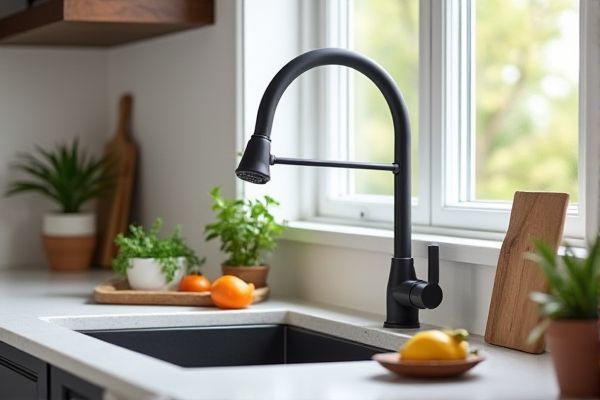
A pot filler is a specialized faucet designed to fill large pots directly on the stove, saving you from lifting heavy containers filled with water, whereas a regular faucet serves general purposes like washing dishes and hands at the sink. Discover how choosing between a pot filler and a regular faucet can impact your kitchen efficiency and convenience by reading the full article.
Table of Comparison
| Feature | Pot Filler | Regular Faucet |
|---|---|---|
| Location | Mounted above stove or cooktop | Mounted at kitchen sink |
| Purpose | Fills pots directly on cooktop | General use (washing, filling, cleaning) |
| Water Reach | Swivel arm extends to pot | Limited to sink basin area |
| Installation | Requires wall plumbing near stove | Standard sink plumbing |
| Water Pressure | Moderate, suitable for filling pots | Variable, designed for multiple uses |
| Cost | Higher due to specialized installation | Lower, widely available options |
| Convenience | Eliminates carrying heavy water pots | Requires pot transfer to sink |
| Usage Frequency | Limited to cooking tasks | Daily multi-purpose use |
Introduction: Pot Filler vs Regular Faucet
Pot fillers are specialized faucets installed near cooking surfaces to fill pots directly, reducing the need to carry heavy containers from the sink, enhancing kitchen efficiency. Regular faucets, typically mounted over kitchen sinks, serve general water-access purposes but require manual transport of water to cooking areas. The choice between pot fillers and regular faucets impacts kitchen functionality, workflow, and design adaptability.
What is a Pot Filler?
A pot filler is a specialized faucet installed near the stove to provide water directly for cooking, eliminating the need to carry heavy pots from the sink. Unlike regular faucets, pot fillers are designed for convenience and efficiency in the kitchen, featuring a long, articulating arm to reach pots on the stovetop. Your kitchen workflow improves significantly with a pot filler by reducing spills and saving time during meal preparation.
Understanding Regular Kitchen Faucets
Regular kitchen faucets are typically designed for general use, featuring standard flow rates and positioned over sinks to handle everyday tasks such as washing dishes and filling pots. Unlike pot fillers, which are installed near the stove for convenient direct filling of cookware, regular faucets may require you to carry heavy pots across the kitchen. Their versatility and broad application make them essential for various kitchen activities beyond just filling large pots.
Design and Placement Differences
Pot fillers are typically wall-mounted above the stove, featuring a foldable, articulated arm designed for easy extension and retraction, making them ideal for filling pots directly on the cooktop. Regular faucets are installed on sinks with a fixed or swivel spout and are primarily intended for general kitchen use, including washing dishes and hands. Your choice between a pot filler and a regular faucet depends on kitchen layout and convenience, as pot fillers save time and reduce heavy lifting while regular faucets offer versatile water access.
Installation Requirements and Costs
Pot fillers require professional installation near the stove, involving plumbing modifications that can increase labor costs compared to regular faucets, which are typically easier and less expensive to install at standard sink locations. The complexity of pot filler installation depends on existing water lines and wall accessibility, potentially raising total expenses significantly. Regular faucets usually involve straightforward hookups with fewer requirements, resulting in lower installation costs ranging from $100 to $300, while pot fillers often cost between $300 and $700 or more, including labor.
Functionality and Convenience Compared
Pot fillers offer the convenience of filling large pots directly on the stove, reducing the need to carry heavy containers across the kitchen. Regular faucets provide versatile water access for various tasks at the sink but may require extra effort when transferring water to pots. Your kitchen efficiency can greatly improve with a pot filler, especially during cooking sessions involving large volumes of water.
Aesthetics and Kitchen Style Impact
Pot fillers add a sleek, modern touch to kitchens by providing a dedicated water source above the stove, enhancing both functionality and visual appeal. Regular faucets, typically mounted on the sink, maintain a traditional aesthetic but may not complement contemporary kitchen designs as effectively. Choosing a pot filler can elevate a kitchen's style by offering a streamlined look that integrates seamlessly with high-end appliances and minimalist decor.
Water Flow and Efficiency
Pot fillers deliver higher water flow rates, often reaching 1.5 to 2 gallons per minute (GPM), enabling faster filling of large pots directly at the stove. Regular faucets typically offer flow rates between 1.0 to 1.5 GPM, designed for general kitchen tasks rather than high-volume filling. Pot fillers improve efficiency by reducing the need to carry heavy pots filled with water, minimizing spills and saving time during cooking preparation.
Maintenance and Durability
Pot fillers typically require less frequent maintenance due to their simpler design and fewer moving parts compared to regular faucets. Regular faucets, exposed to daily use and higher water pressure, often demand more frequent upkeep and are prone to wear and tear, necessitating periodic replacement of cartridges and seals. High-quality pot fillers made from durable materials such as brass or stainless steel offer enhanced longevity, making them a durable addition to kitchen plumbing.
Which is Best for Your Kitchen?
A pot filler offers convenience by providing a water source directly over the stove, minimizing the need to carry heavy pots filled with water from the sink. Regular faucets remain essential for general kitchen tasks like washing dishes and hands, offering versatile functionality in your workspace. Choosing between a pot filler and a regular faucet depends on your cooking habits and kitchen layout, with pot fillers ideal for avid cooks who frequently boil large pots.
 homyna.com
homyna.com